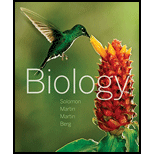
Concept explainers
Test Your Understanding
1. Which of the following is not a shared derived character of echinoderms? (a) water vascular system (b) notochord (c) tube feet (d) pentaradial symmetry in adult (e) endoskeleton of calcium carbonate plates and spines
Introduction: Animal phylogeny is the rapidly changing field for biologists. Even if the members of the animal kingdom are incredibly diverse, there are various animals sharing certain features that differentiate them from other organisms of the kingdom. The most highly derived body plan among all animals of the animal kingdom is echinoderm. Echinoderms are the animals that have no terrestrial or freshwater representatives and these animals belong to marine habitat.
Answer to Problem 1TYU
Correct answer: The presence of notochord is not a shared derived character of echinoderms. Hence, the correct answer is option (b).
Explanation of Solution
Reason for the correct answer:
The shared derived characters of echinoderms are as follows:
- Presence of water vascular system.
- Presence of numerous tiny tube feet.
- Presence of endoskeleton, ciliated epidermis, and thin covering.
- The adults of echinoderms exhibit pentaradial symmetry.
The presence of notochord is one of the characters of chordates. Some of the chordates have notochord during some time of their developmental cycle, whereas some chordates have notochord during their whole life time like vertebrates. It is not the shared derived character of echinoderms.
Option (b) is given as “notochord”.
The presence of notochord is not a shared derived character of echinoderms. Hence, the correct answer is option (b).
Reasons for the incorrect answers:
Option (a) is given as “water vascular system”.
The unique structural derived character of echinoderms is the presence of a network of fluid-filled canals and chambers called water vascular system. Hence, option (a) is incorrect.
Option (c) is given as “tube feet”.
The presence of numerous tiny tube feet is one the structural unique character of echinoderms. Hence, option (c) is incorrect.
Option (d) is given as “pentaradial symmetry in adult”.
The echinoderm adult exhibits pentaradial symmetry and the larval form exhibits bilateral symmetry. Hence, option (d) is incorrect.
Option (e) is given as “endoskeleton of calcium carbonate plates and spines”.
The presence of endoskeleton, ciliated epidermis, and thin covering is the unique feature of echinoderm. The endoskeleton of echinoderms consists of calcium carbonate (CaCO3) spines and plates. Hence, option (e) is incorrect.
Hence, options (a), (c), (d), and (e) are incorrect.
The presence of notochord is not a shared derived character of echinoderms.
Want to see more full solutions like this?
Chapter 32 Solutions
Biology (MindTap Course List)
- Describe the principle of homeostasis.arrow_forwardExplain how the hormones of the glands listed below travel around the body to target organs and tissues : Pituitary gland Hypothalamus Thyroid Parathyroid Adrenal Pineal Pancreas(islets of langerhans) Gonads (testes and ovaries) Placentaarrow_forwardWhat are the functions of the hormones produced in the glands listed below: Pituitary gland Hypothalamus Thyroid Parathyroid Adrenal Pineal Pancreas(islets of langerhans) Gonads (testes and ovaries) Placentaarrow_forward
- Describe the hormones produced in the glands listed below: Pituitary gland Hypothalamus Thyroid Parathyroid Adrenal Pineal Pancreas(islets of langerhans) Gonads (testes and ovaries) Placentaarrow_forwardPlease help me calculate drug dosage from the following information: Patient weight: 35 pounds, so 15.9 kilograms (got this by dividing 35 pounds by 2.2 kilograms) Drug dose: 0.05mg/kg Drug concentration: 2mg/mLarrow_forwardA 25-year-old woman presents to the emergency department with a 2-day history of fever, chills, severe headache, and confusion. She recently returned from a trip to sub-Saharan Africa, where she did not take malaria prophylaxis. On examination, she is febrile (39.8°C/103.6°F) and hypotensive. Laboratory studies reveal hemoglobin of 8.0 g/dL, platelet count of 50,000/μL, and evidence of hemoglobinuria. A peripheral blood smear shows ring forms and banana-shaped gametocytes. Which of the following Plasmodium species is most likely responsible for her severe symptoms? A. Plasmodium vivax B. Plasmodium ovale C. Plasmodium malariae D. Plasmodium falciparumarrow_forward
- please fill in missing parts , thank youarrow_forwardplease draw in the answers, thank youarrow_forwarda. On this first grid, assume that the DNA and RNA templates are read left to right. DNA DNA mRNA codon tRNA anticodon polypeptide _strand strand C с A T G A U G C A TRP b. Now do this AGAIN assuming that the DNA and RNA templates are read right to left. DNA DNA strand strand C mRNA codon tRNA anticodon polypeptide 0 A T G A U G с A TRParrow_forward
 Biology (MindTap Course List)BiologyISBN:9781337392938Author:Eldra Solomon, Charles Martin, Diana W. Martin, Linda R. BergPublisher:Cengage Learning
Biology (MindTap Course List)BiologyISBN:9781337392938Author:Eldra Solomon, Charles Martin, Diana W. Martin, Linda R. BergPublisher:Cengage Learning Biology: The Dynamic Science (MindTap Course List)BiologyISBN:9781305389892Author:Peter J. Russell, Paul E. Hertz, Beverly McMillanPublisher:Cengage Learning
Biology: The Dynamic Science (MindTap Course List)BiologyISBN:9781305389892Author:Peter J. Russell, Paul E. Hertz, Beverly McMillanPublisher:Cengage Learning Biology 2eBiologyISBN:9781947172517Author:Matthew Douglas, Jung Choi, Mary Ann ClarkPublisher:OpenStax
Biology 2eBiologyISBN:9781947172517Author:Matthew Douglas, Jung Choi, Mary Ann ClarkPublisher:OpenStax
 Biology: The Unity and Diversity of Life (MindTap...BiologyISBN:9781337408332Author:Cecie Starr, Ralph Taggart, Christine Evers, Lisa StarrPublisher:Cengage Learning
Biology: The Unity and Diversity of Life (MindTap...BiologyISBN:9781337408332Author:Cecie Starr, Ralph Taggart, Christine Evers, Lisa StarrPublisher:Cengage Learning Biology: The Unity and Diversity of Life (MindTap...BiologyISBN:9781305073951Author:Cecie Starr, Ralph Taggart, Christine Evers, Lisa StarrPublisher:Cengage Learning
Biology: The Unity and Diversity of Life (MindTap...BiologyISBN:9781305073951Author:Cecie Starr, Ralph Taggart, Christine Evers, Lisa StarrPublisher:Cengage Learning





